THURSDAY 18 NOV 2021 AT 11 AM
HAIDA HOUSE AT THE MUSEUM OF ANTHROPOLOGY, 6393 NW Marine Drive, UBC
Concert at Haida House: Melody Courage Responds to Tania Willard
-
Melody Courage
PerformerVancouver-based Métis soprano Melody Courage, of Dene, Cree and Chipewyan descent, gained national attention as The Native Girl in the 2017 world premiere of Marie Clements’ and Brian Current’s opera Missing, co-produced by City Opera Vancouver and Pacific Opera Victoria. Missing gives voice, in English and Gitxsan, to the story of Canada’s missing and murdered Indigenous women. Courage received her degree and diploma in Opera Performance from the Vancouver Academy of Music after music studies at the University of British Columbia, followed by guest appearances in Vivaldi’s Gloria with the National Arts Centre Orchestra and The Messiah with the Prince George Symphony Orchestra.
Read More
-
Tania Willard
ArtistTania Willard (Secwépemc Nation, b. 1977) is an artist and curator of mixed Secwépemc and settler ancestry and beginning January 2026, the Belkin’s Director/Curator. Willard’s research and creative processes are informed by land-based and community-engaged art practices, connections to culture and family, and intersections between Aboriginal and other cultures. Often focusing on Secwépemc aesthetics, language and land, Willard explores the shifts and tensions between ideas of the contemporary and the traditional. Willard centres art as an Indigenous resurgent act through her collaborative projects and her support of language revitalization efforts in Secwépemc communities. Willard’s personal curatorial projects include BUSH gallery, a conceptual space for land-based art and action led by Indigenous artists. Willard received an MFA from UBC Okanagan in 2018. Her work has been the subject of solo exhibitions at Kamloops Art Gallery; Burnaby Art Gallery; and SFU Audain Gallery, Vancouver. Her work has been featured in group exhibitions at FotoFocus Biennial; Cincinnati Arts Centre; Haus der Kulturen der Welt, Berlin Germany; Morris and Helen Belkin Art Gallery; and Open Studio Contemporary Printmaking Centre, Toronto. Willard has curated numerous exhibitions, including the traveling exhibition Beat Nation: Art, Hip Hop and Aboriginal Culture that began at the Vancouver Art Gallery (co-curated with Kathleen Ritter); Exposure: Native Art and Political Ecology at the IAIA Museum of Contemporary Native Arts, Santa Fe; Unceded Territories: Lawrence Paul Yuxweluptun at the Museum of Anthropology (co-curated with Karen Duffek); and CUSTOM MADE at Kamloops Art Gallery. She was a curator in residence with grunt gallery and Kamloops Art Gallery. Willard was selected as one of five curators for a national scope exhibition in collaboration with Partners in Art and National Parks. She received the 2016 Hnatyshyn Foundation Award for Curatorial Excellence in Contemporary Art, the 2020 Shadbolt Foundation VIVA Award, and was named a 2022 Forge Project Fellow. Her work with BUSH gallery was recognized through the Ruth Foundation for the Arts Future Studies award (2022). Willard is an Assistant Professor in the Faculty of Creative and Critical Studies and Gallery Director at UBC Okanagan in Syilx territories (Kelowna, BC).
Read More
A year after it was first performed and in collaboration with composer Patrick Carrabré, Métis soprano Melody Courage will interpret Tania Willard’s Woodpile Score (2018) through vocal performance at Haida House outside the Museum of Anthropology, UBC on Thursday, November 18 at 11 am. In the fall of 2020, Courage performed this same work as part of the exhibition Soundings: An Exhibition in Five Parts at the Morris and Helen Belkin Art Gallery for an online audience. As The Score Research Cluster enters its second year and with the possibility of in-person events a reality again, the Belkin, the School of Music and the Chan Centre for Performing Arts and with the support of the Museum of Anthropology are thrilled to revisit this performance by Courage.
As part of Soundings, Tania Willard’s Surrounded/Surrounding included a wood-burning fire bowl, etched leather camp stools and a life-sized rendering of the artist’s wood pile in a graphic score. Written on the split logs and the spaces between them are references to the breathing, beating labour that creates what a fire needs, as well as the trees, sun, sky and ground that surrounds and creates all else. Cursive text adorns the twelve camp stools, shifting from embraced to embracing, from enclosed to enclosing. The installation anticipated the event it was proposing and these words evoked the transition from proposition to action.
During the course of the Soundings exhibition, Melody Courage worked with composer Patrick Carrabré to interpret and respond to Willard’s Woodpile Score, reflecting on the themes of Surrounded/Surrounding in vocal performance. Due to COVID-19 restrictions at the time, the event took place online, with Tania Willard hosting an Instagram Live event from Secwépemc Territory, where she lit a fire and asked people to join her remotely as witnesses. The Belkin joined Willard with documentation of Melody Courage’s performance.
The Score Research Cluster
Through the performance and study of unconventional scores by Indigenous artists, the UBC Score Research Cluster engages with decolonization by challenging existing sonic, physical and conceptual frames of Indigenous and settler–colonial knowledge. The research-creation team consists of an interdisciplinary network of scholars as part of UBC Research Excellence Clusters, attending to relationships between art, site and sound. This cluster was established through participation with the exhibition Soundings: An Exhibition in Five Parts held at the Belkin from 8 September to 6 December 2020.
Image (above): Melody Courage performing alongside Tania Willard’s Surrounded/Surrounding, 2020.
-
Melody Courage
PerformerVancouver-based Métis soprano Melody Courage, of Dene, Cree and Chipewyan descent, gained national attention as The Native Girl in the 2017 world premiere of Marie Clements’ and Brian Current’s opera Missing, co-produced by City Opera Vancouver and Pacific Opera Victoria. Missing gives voice, in English and Gitxsan, to the story of Canada’s missing and murdered Indigenous women. Courage received her degree and diploma in Opera Performance from the Vancouver Academy of Music after music studies at the University of British Columbia, followed by guest appearances in Vivaldi’s Gloria with the National Arts Centre Orchestra and The Messiah with the Prince George Symphony Orchestra.
Read More
-
Tania Willard
ArtistTania Willard (Secwépemc Nation, b. 1977) is an artist and curator of mixed Secwépemc and settler ancestry and beginning January 2026, the Belkin’s Director/Curator. Willard’s research and creative processes are informed by land-based and community-engaged art practices, connections to culture and family, and intersections between Aboriginal and other cultures. Often focusing on Secwépemc aesthetics, language and land, Willard explores the shifts and tensions between ideas of the contemporary and the traditional. Willard centres art as an Indigenous resurgent act through her collaborative projects and her support of language revitalization efforts in Secwépemc communities. Willard’s personal curatorial projects include BUSH gallery, a conceptual space for land-based art and action led by Indigenous artists. Willard received an MFA from UBC Okanagan in 2018. Her work has been the subject of solo exhibitions at Kamloops Art Gallery; Burnaby Art Gallery; and SFU Audain Gallery, Vancouver. Her work has been featured in group exhibitions at FotoFocus Biennial; Cincinnati Arts Centre; Haus der Kulturen der Welt, Berlin Germany; Morris and Helen Belkin Art Gallery; and Open Studio Contemporary Printmaking Centre, Toronto. Willard has curated numerous exhibitions, including the traveling exhibition Beat Nation: Art, Hip Hop and Aboriginal Culture that began at the Vancouver Art Gallery (co-curated with Kathleen Ritter); Exposure: Native Art and Political Ecology at the IAIA Museum of Contemporary Native Arts, Santa Fe; Unceded Territories: Lawrence Paul Yuxweluptun at the Museum of Anthropology (co-curated with Karen Duffek); and CUSTOM MADE at Kamloops Art Gallery. She was a curator in residence with grunt gallery and Kamloops Art Gallery. Willard was selected as one of five curators for a national scope exhibition in collaboration with Partners in Art and National Parks. She received the 2016 Hnatyshyn Foundation Award for Curatorial Excellence in Contemporary Art, the 2020 Shadbolt Foundation VIVA Award, and was named a 2022 Forge Project Fellow. Her work with BUSH gallery was recognized through the Ruth Foundation for the Arts Future Studies award (2022). Willard is an Assistant Professor in the Faculty of Creative and Critical Studies and Gallery Director at UBC Okanagan in Syilx territories (Kelowna, BC).
Read More
Related
-
Research Project
2019 - Ongoing
The Score: Performing, Listening and Decolonization
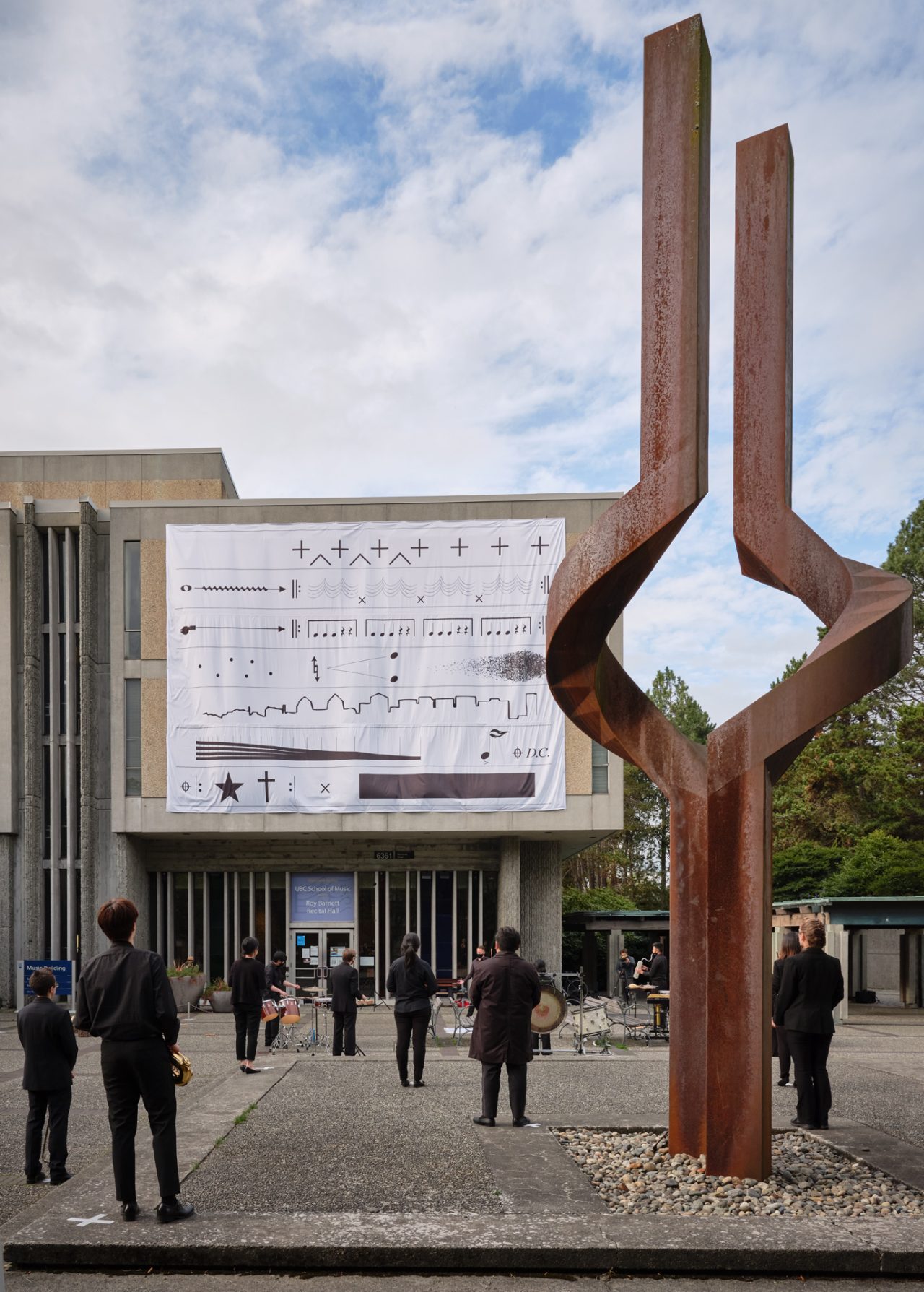
Through the performance and study of unconventional scores by Indigenous artists, the Score Research Cluster engages with decolonization by challenging existing sonic, physical and conceptual frames of Indigenous and settler–colonial knowledge.
[more] -
Exhibition
8 Sep – 6 Dec 2020
Soundings: An Exhibition in Five Parts
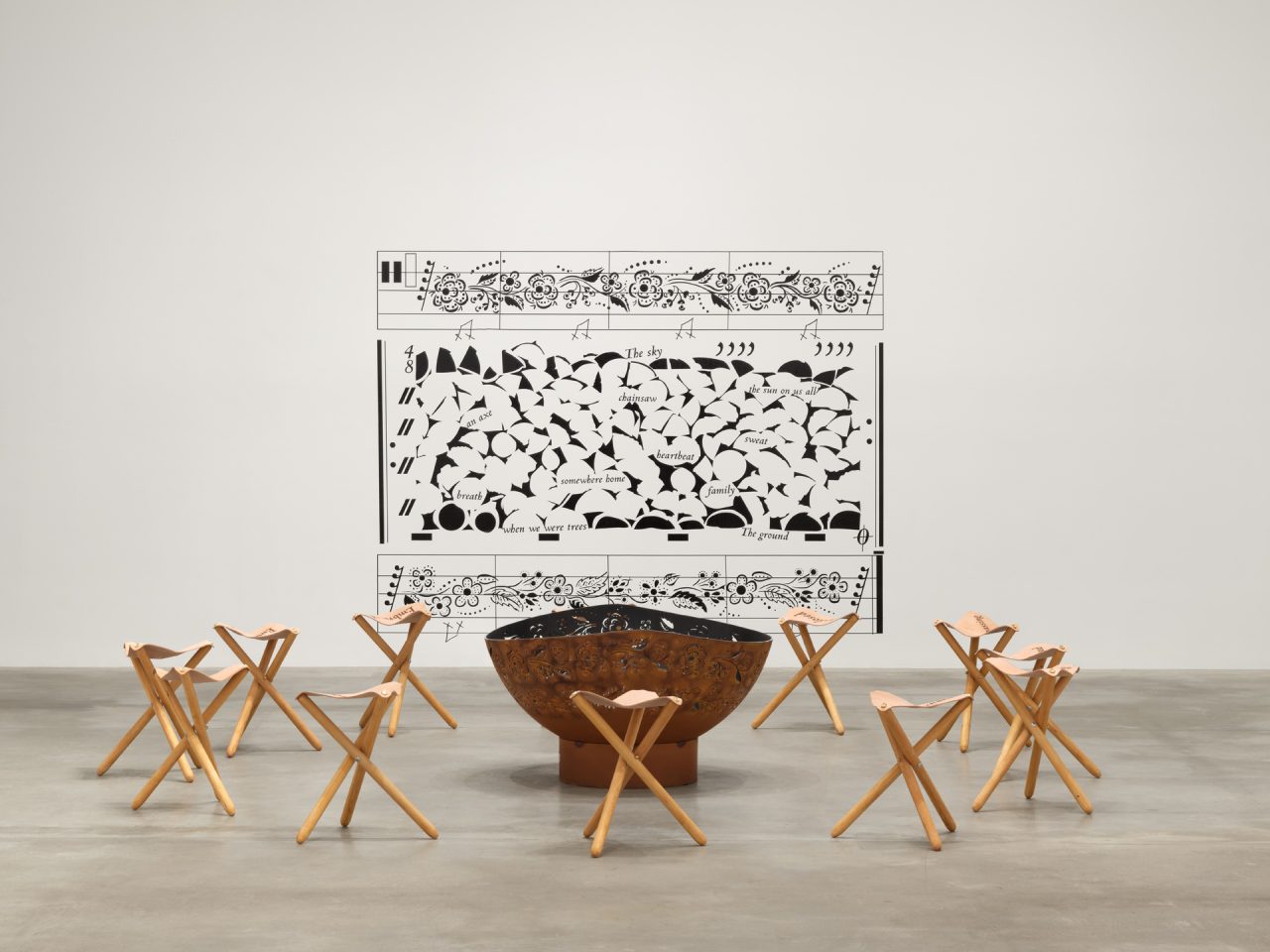
Soundings: An Exhibition in Five Parts features newly commissioned scores, performances, videos, sculptures and sound by Indigenous and other artists who respond to the question, How can a score be a call and tool for decolonization? Unfolding in a sequence of five parts, the scores take the form of beadwork, videos, objects, graphic notation, historical belongings and written instructions. During the exhibition, these scores are activated at specific moments by musicians, dancers, performers and members of the public, gradually filling the gallery and surrounding public spaces with sound and action. Curated by Candice Hopkins and Dylan Robinson, Soundings is cumulative, limning an ever-changing community of artworks, shared experience and engagement. Shifting and evolving, it gains new artists and players in each location. For this iteration on Musqueam territory, the Belkin has collaborated with UBC's Musqueam Language Program in partnership with the Musqueam Indian Band Language and Culture Department; School of Music; Chan Centre for Performing Arts; First Nations House of Learning and Museum of Anthropology to support the production of new artworks and performances by local artists.
[more] -
Event
Monday 30 Nov 2020 at 4:30 pm
Soundings: Tania Willard and Melody Courage

Surrounded/Surrounding includes a wood-burning fire bowl, etched leather camp stools and a life-sized rendering of the artist’s wood pile in a graphic score. Written on the split logs and the spaces between them are references to the breathing, beating labour that creates what a fire needs, as well as the trees, sun, sky and ground that surrounds and creates all else.
[more] -
Event
Wednesday 20 Oct 2021 at 12:30 pm
The Score: Ladner Clock Tower Carillon Performance

As The Score Research Cluster enters its second year, the Belkin and the School of Music are revisiting performances done as part of Soundings: An Exhibition in Five Parts from the fall of 2020. Athena Loredo's Strata Tempora (2020) is an interpretation of Olivia Whetung's Strata (2018) as a musical score, performed through the carillon and a brass ensemble at the Ladner Clock Tower. Initially performed in 2020, when much of UBC campus was shut down or quieted due to the COVID-19 pandemic, the work will be performed again in October 2021, when the rhythms of more typical years at UBC are present on campus.
[more] -
Event
Sunday 8 Nov 2020 at 3 pm
Soundings: Camille Georgeson-Usher and Rachel Kiyo Iwaasa

through, in between oceans part 2 by Camille Georgeson-Usher is a beaded installation, completed during the isolation of the Spring 2020 pandemic. The artist worked from home in Toronto, a departure from her intention to spend several months on Galiano Island, BC, where she was raised.
[more] -
Event
10 Sep 2020
Soundings: Diamond Point and Coastal Wolf Pack

Forming two continuous lines on this part of the traditional, ancestral and unceded territory of the xʷməθkʷəy̓əm (Musqueam) people, wəɬ m̓i ct q̓pəθət tə ɬniməɬ by Diamond Point presents two images repeating in a sequence hung on the lampposts along UBC’s Main Mall from James Hart’s Reconciliation Pole to the plaza just beyond the Belkin.
[more] -
Event
Soundings: Germaine Koh
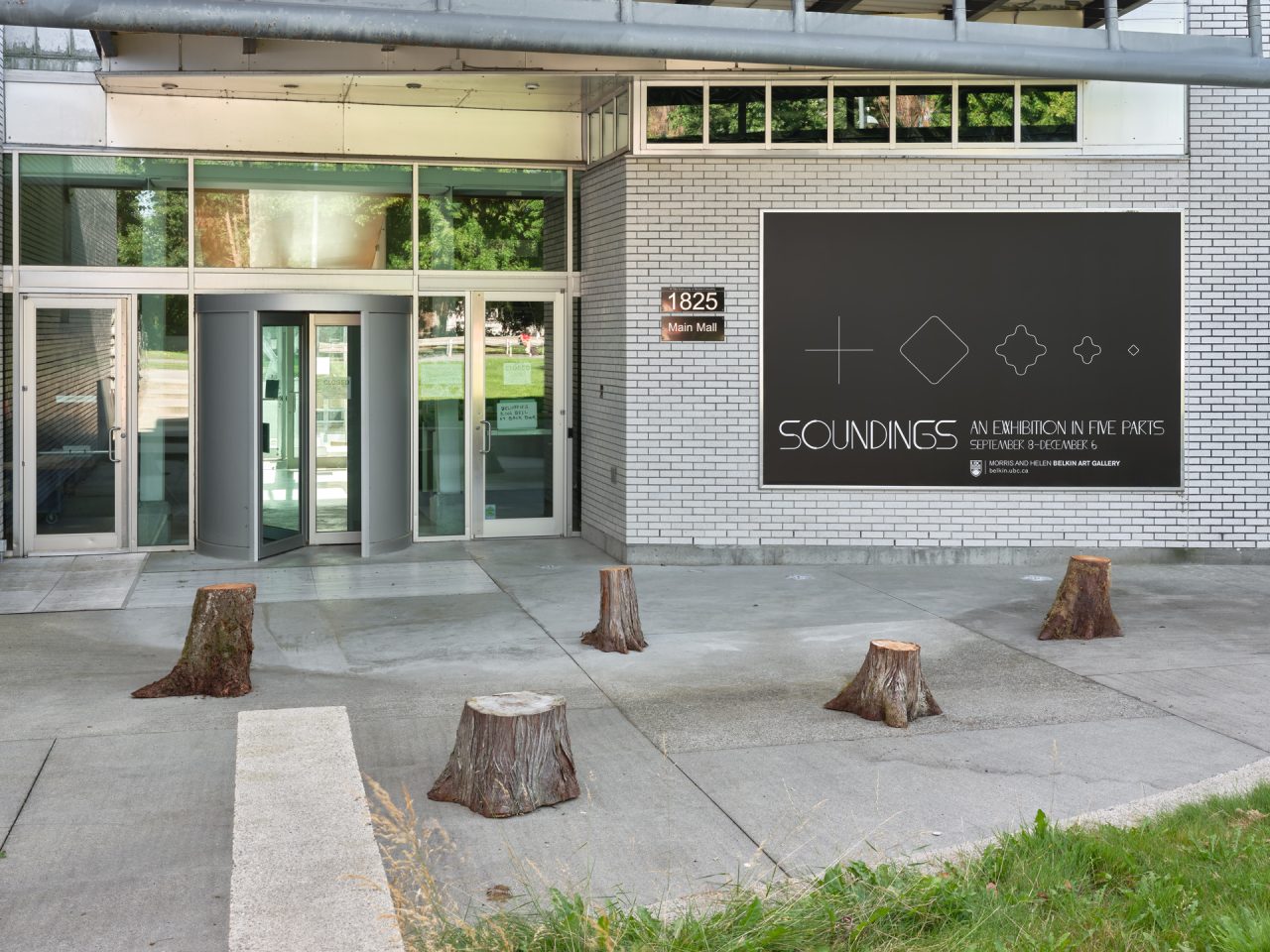
Germaine Koh’s drum is made from one of the cedar tree stumps she first brought to site for use as physical distancing stations. She worked with Belkin staff during Summer 2020 to develop COVID-19 safety and visitor interaction protocols that recognized the importance of collective care and teamwork.
[more] -
Event
8 Sep 2020
Soundings: Greg Staats
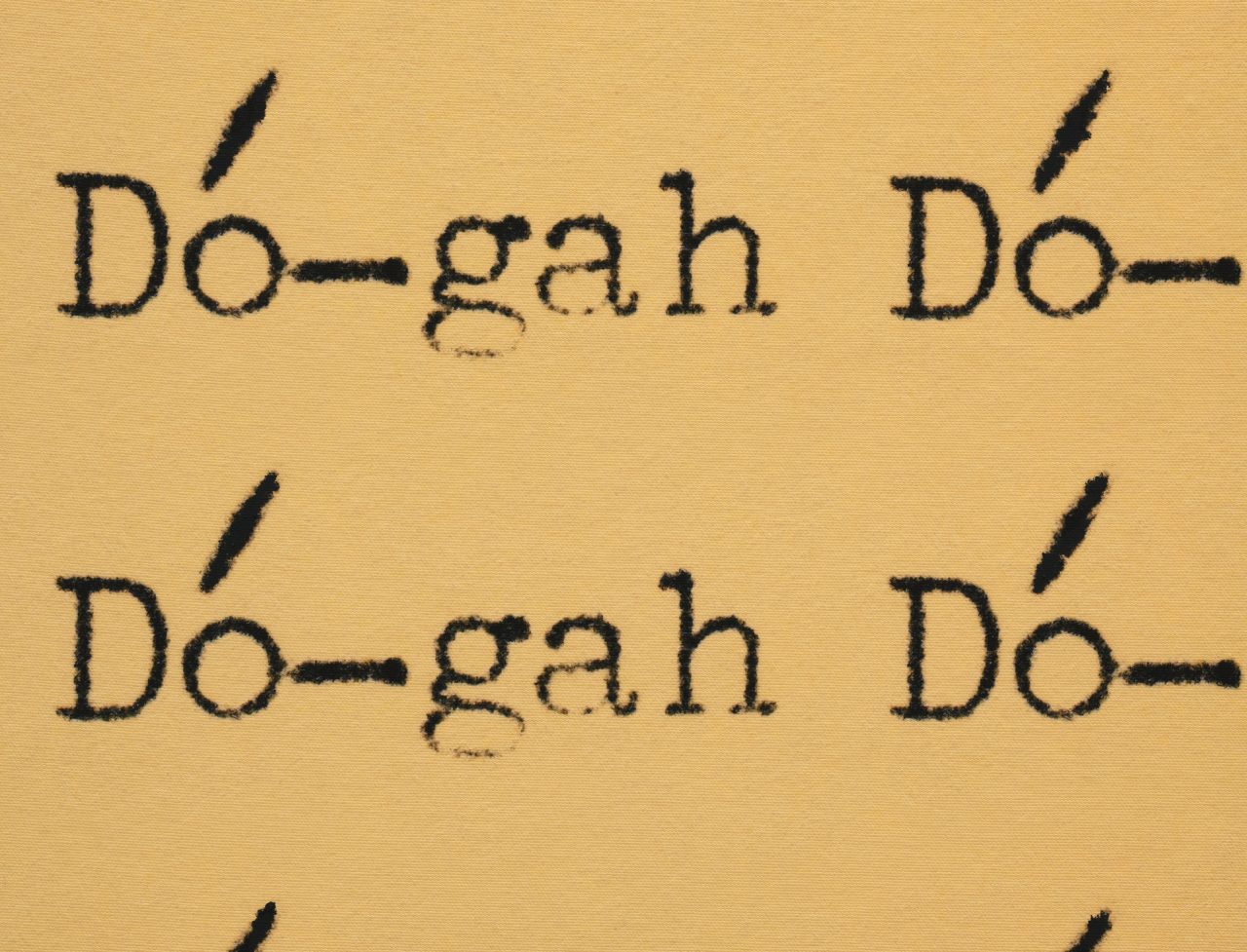 [more]
[more] -
Event
Wednesday 21 Oct 2020 at 3 pm
Wednesday 28 Oct 2020 at 3 pm
Wednesday 25 Nov 2020 at 2 pm
Wednesday 2 Dec 2020 at 3 pm
Sunday 6 Dec 2020 at 3 pm
Soundings: Olivia Whetung and the Ladner Clock Tower Carillon
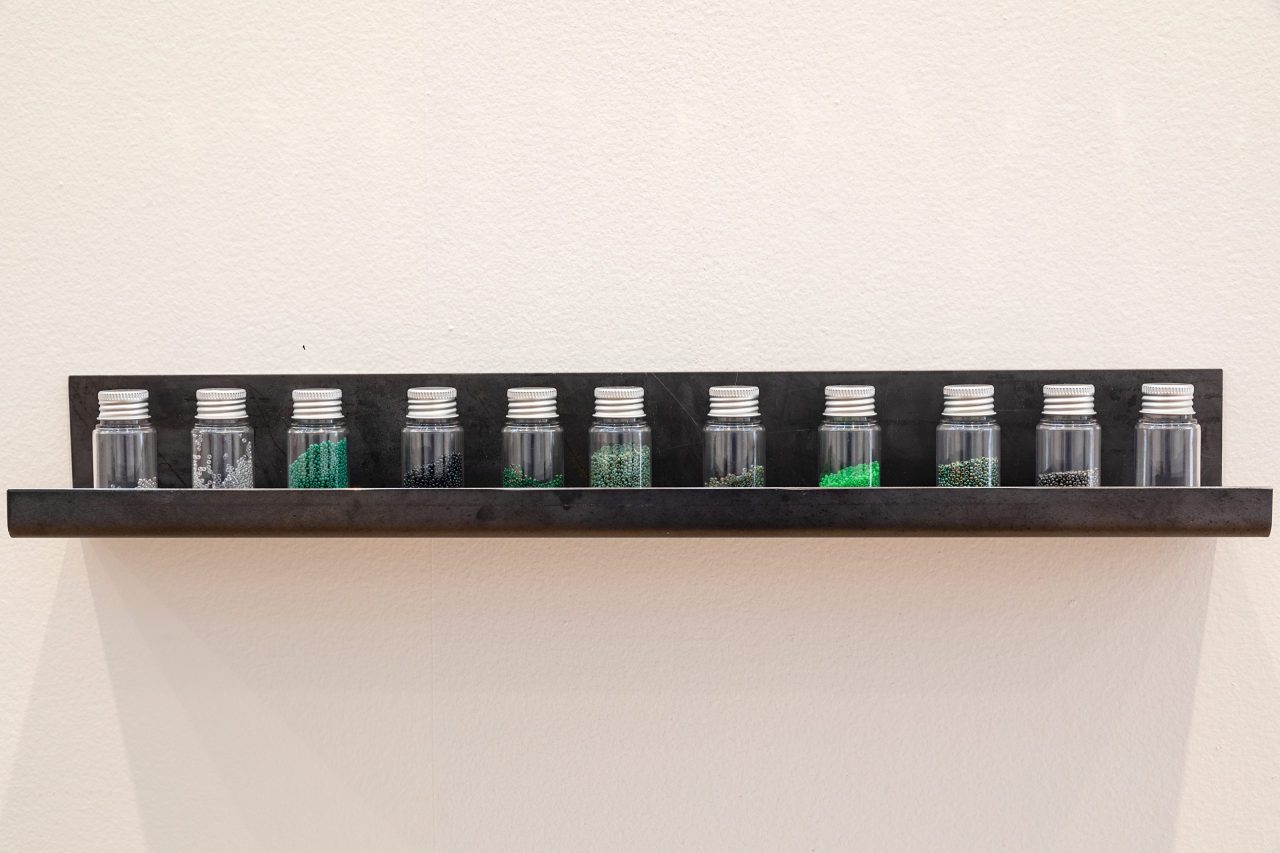
Whetung invites gallery visitors to pour different coloured beads from individual small jars into one large vessel, creating a layering of sounds as each bead joins the growing pile. Once the container is filled, the artist turns the amalgam of beads into an entirely new piece – a rectangular beadwork unique to the Belkin’s iteration of the exhibition.
[more] -
Event
8 Sep 2020
Soundings: Peter Morin and Parmela Attariwala
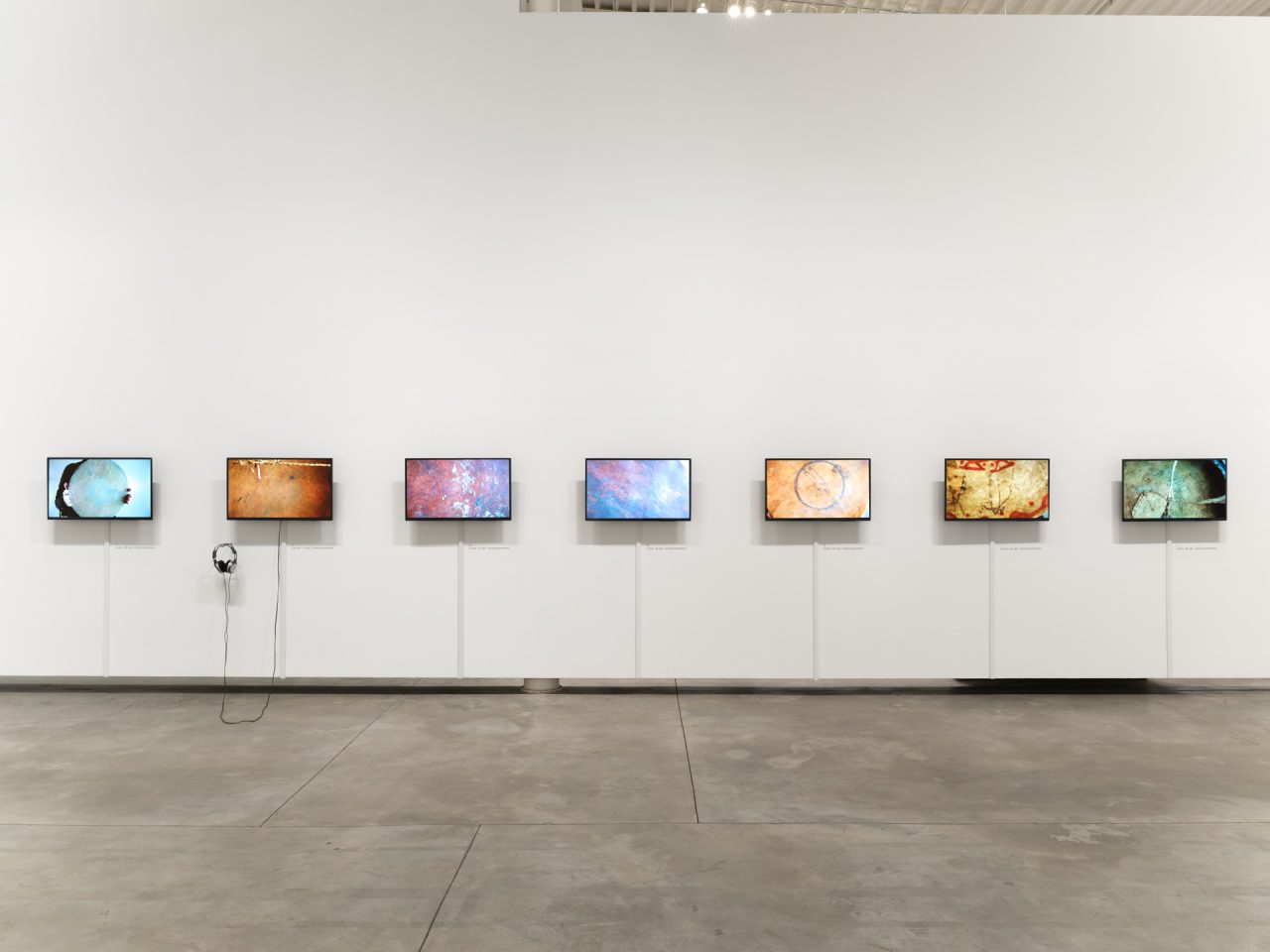
In Part One of NDN Love Songs, Peter Morin offers a score of instructions to musicians presented alongside seven video portraits. Part Two presents videos of recordings of previous iterations of the Soundings exhibition at Agnes Etherington Art Centre, Gund Gallery and Kitchener-Waterloo Art Gallery. In Part Three, Parmela Attariwala performs the score on the violin at the Belkin.
[more] -
Event
8 Oct 2020 at 4 pm
Soundings: Raven Chacon and Symphonic Wind Ensemble
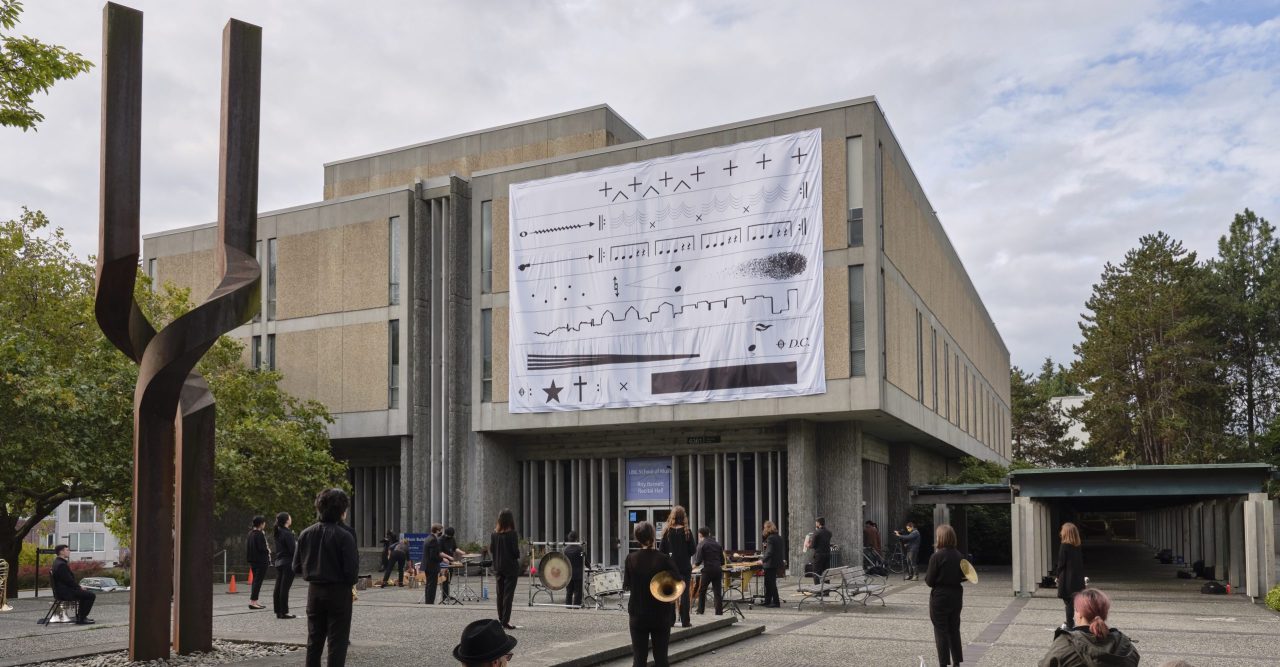
Around the corner from the Belkin Gallery, Raven Chacon's score American Ledger (No. 1) hangs on the exterior of the Music Building at 6361 Memorial Road, UBC. The score incorporates a traditional musical score with Navajo iconography and is to be performed by "many players with sustaining and percussive instruments, voices, coins, axe and wood, a police whistle and the striking of a match."
[more] -
Event
Dec 2020
Soundings: UBC Contemporary Players Respond
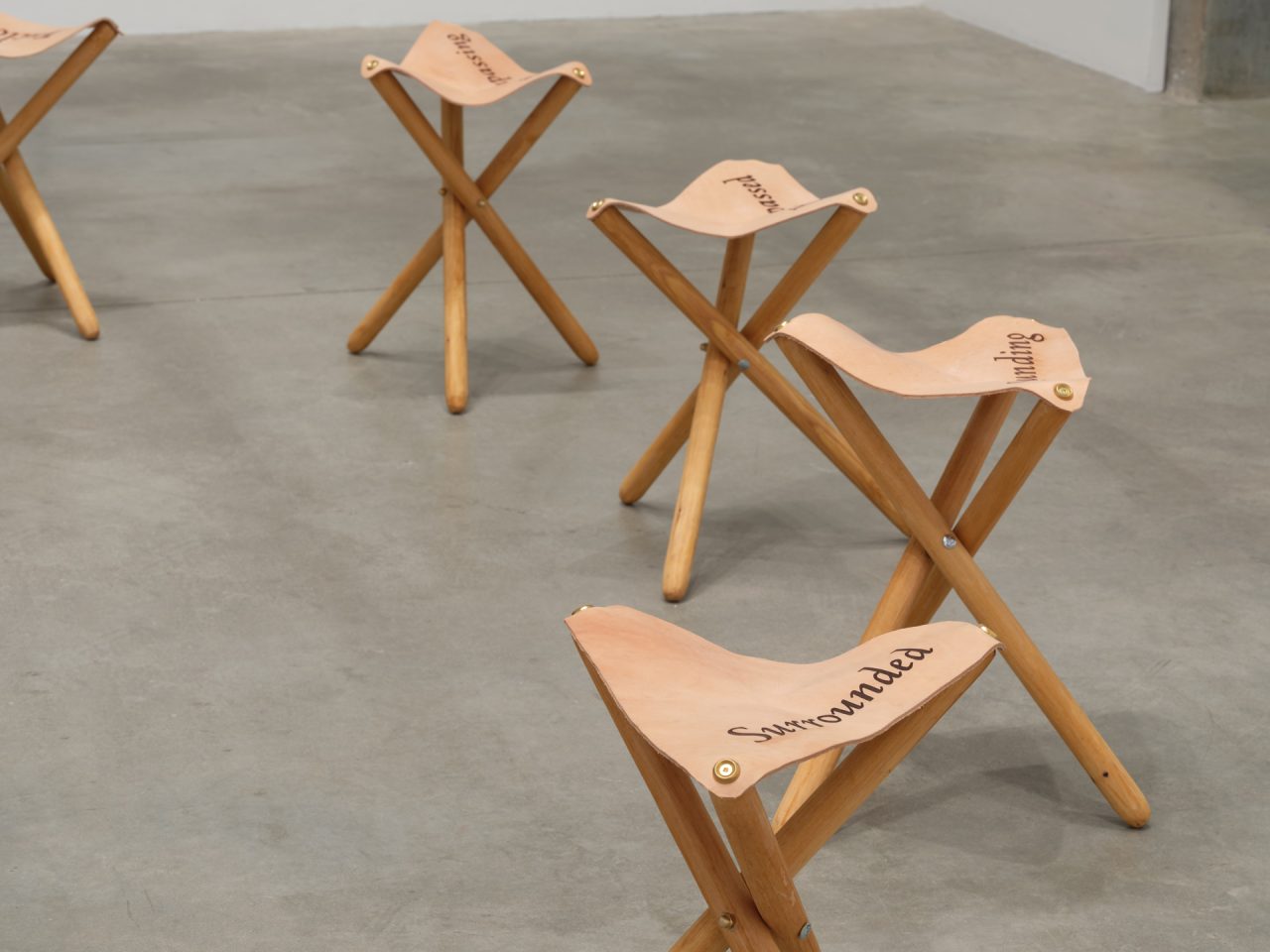
In lieu of a public concert at the Belkin as has occurred in recent years, musicians from UBC Contemporary Players chose a work by a Canadian composer to perform in an empty gallery, responding to the works of Soundings: An Exhibition in Five Parts. Videos of these performances are shared here for reference, research, and enjoyment in perpetuity. Soundings asks how a score can be a call and a tool for decolonization. The exhibition's corresponding investigations take at their centre questions of embodiment and subjectivity, of calls and responses. What are the practical matters of embodied decolonization, and how can we practice them? How does embodiment facilitate unlearning, unknowing, and the visioning of Indigenous ontologies?
[more] -
News
10 Dec 2020
Soundings: Marking Time
 [more]
[more] -
News
31 Aug 2020
Soundings: Reading Room
The following is a list of resources related to Soundings: An Exhibition in Five Parts. The list of resources compiled here is not an official recommendation, but is rather a list of suggested readings compiled by Public Programs and graduate student researchers at the Belkin Art Gallery. These readings are intended to provide additional context for the exhibition and act as springboards for further research or questions stemming from the exhibition, artists, and works involved.
[more] -
News
30 Nov 2020
Belkin x CRWR: Soundings
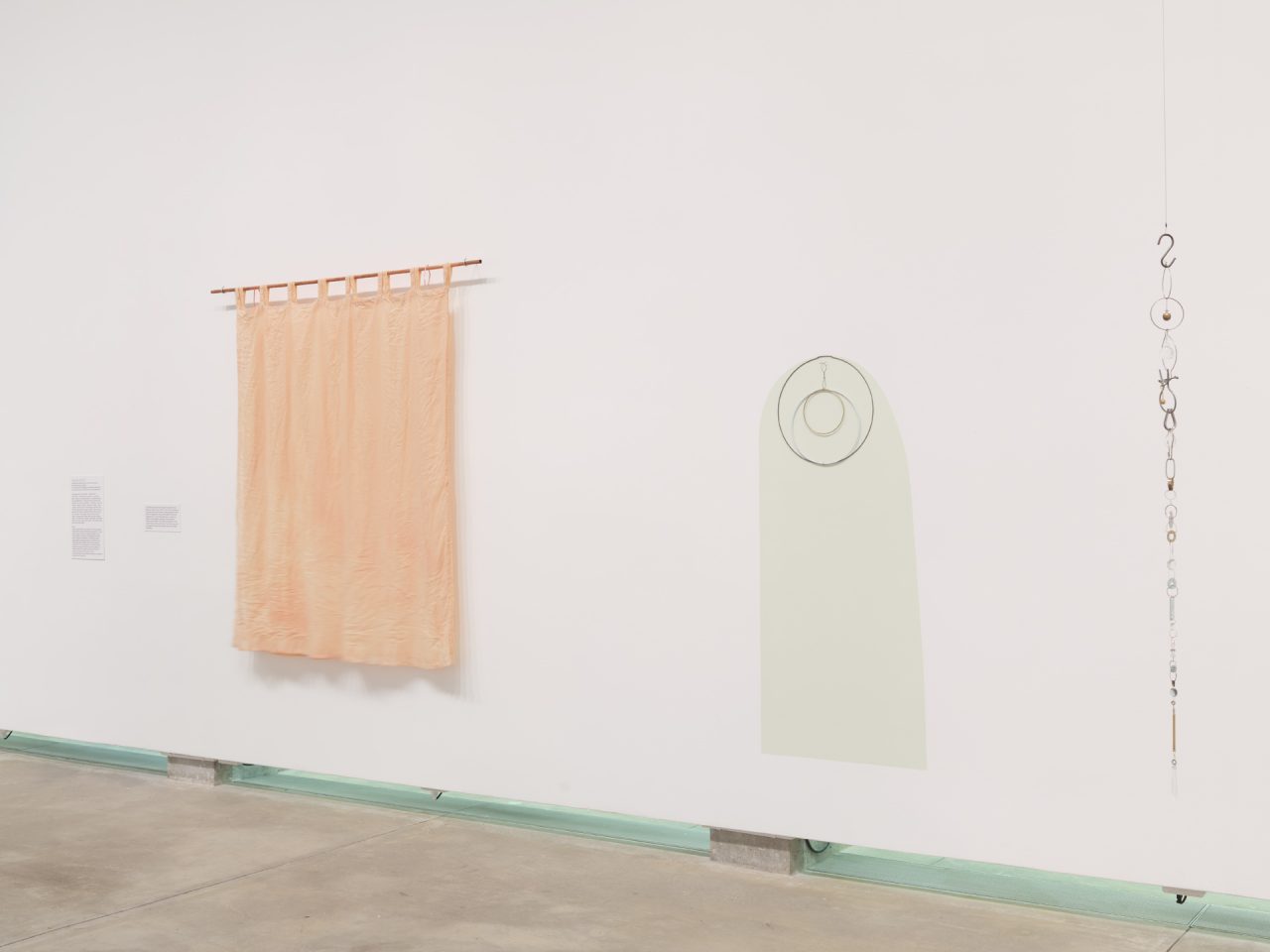
In response to Soundings: An Exhibition in Five Parts, a group of Creative Writing graduate students at the University of British Columbia have made a series of activities for visitors to take part in during their visits to the gallery. Thinking through the idea of a score as a call to respond, these activities range from sound walks to reflective worksheets to small group workshops.
[more]